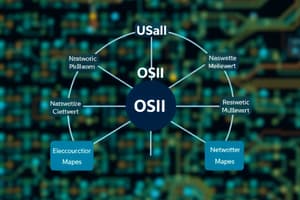Podcast
Questions and Answers
Which type of network is specifically designed for close-range communication using technologies like Bluetooth?
Which type of network is specifically designed for close-range communication using technologies like Bluetooth?
- Campus Area Network (CAN)
- Personal Area Network (PAN) (correct)
- Wide Area Network (WAN)
- Local Area Network (LAN)
What is the primary difference between the OSI model and the TCP/IP model?
What is the primary difference between the OSI model and the TCP/IP model?
- OSI has 4 layers while TCP/IP has 7 layers.
- OSI model consists of 7 layers while TCP/IP model is simplified to 4 layers. (correct)
- TCP/IP is only theoretical while OSI is practically used.
- TCP/IP focuses on data link functions while OSI does not.
Which organization is responsible for managing IP addresses?
Which organization is responsible for managing IP addresses?
- IANA (correct)
- ITU
- IEEE
- ANSI
Which layer of the OSI model is responsible for managing the transmission and reception of raw bits over a physical medium?
Which layer of the OSI model is responsible for managing the transmission and reception of raw bits over a physical medium?
What best describes the difference between hubs and switches in networking?
What best describes the difference between hubs and switches in networking?
Which of the following correctly defines 'Fiber Optic' transmission media?
Which of the following correctly defines 'Fiber Optic' transmission media?
What describes the role of the Logical Link Control (LLC) sublayer in networking?
What describes the role of the Logical Link Control (LLC) sublayer in networking?
Which of the following cable categories offers the highest data transfer rate?
Which of the following cable categories offers the highest data transfer rate?
What is the primary function of the Network Layer?
What is the primary function of the Network Layer?
What is a characteristic of the Transmission Control Protocol (TCP)?
What is a characteristic of the Transmission Control Protocol (TCP)?
Which of the following is an example of CIDR notation?
Which of the following is an example of CIDR notation?
Which protocol is responsible for translating human-readable domain names to IP addresses?
Which protocol is responsible for translating human-readable domain names to IP addresses?
What distinguishes the well-known port range from dynamic/private port range?
What distinguishes the well-known port range from dynamic/private port range?
What is one advantage of using IPv6 over IPv4?
What is one advantage of using IPv6 over IPv4?
Which step in troubleshooting methodology involves gathering information about the problem?
Which step in troubleshooting methodology involves gathering information about the problem?
What type of network architecture involves a centralized server providing resources to clients?
What type of network architecture involves a centralized server providing resources to clients?
Flashcards are hidden until you start studying
Study Notes
Network Types
- Personal Area Network (PAN): Short-range network for devices close together, often using Bluetooth. Examples include a phone connected to a smartwatch or a wireless headset.
- Local Area Network (LAN): Connects devices in a small to medium area like a home, office, or building. Uses Ethernet for wired and wireless connections.
- Campus Area Network (CAN): Covers a larger geographical area, like a university campus or corporate office park.
- Wide Area Network (WAN): Spans vast distances, connecting cities, countries, or even continents. Utilizes diverse technologies like SONET and Frame Relay.
OSI vs. TCP/IP Models
- OSI (Open Systems Interconnection) Model: A 7-layer model that defines network communication functions. Each layer has a specific role.
- Layers: Physical, Data Link, Network, Transport, Session, Presentation, Application.
- TCP/IP (Transmission Control Protocol/Internet Protocol) Model: Simpler 4-layer model commonly used in practical applications.
- Layers: Network Access, Internet, Transport, Application.
Standards and Organizations
- IANA (Internet Assigned Numbers Authority): Manages IP addresses, ensuring unique addresses globally.
- IEEE (Institute of Electrical and Electronics Engineers): Sets standards for physical equipment like network cards and defines MAC addresses.
- ANSI (American National Standards Institute), ITU (International Telecommunication Union), ISO (International Organization for Standardization): Oversee various international and national standards for telecommunications and data communications.
Physical Layer (Layer 1)
- Role: Manages the transmission and reception of raw data bits over a physical medium.
- Transmission Types:
- Simplex: Data transmission only occurs in one direction (e.g., TV broadcast).
- Half-Duplex: Data transmission happens in both directions, but only one direction at a time (e.g., walkie-talkie).
- Full Duplex: Data transmission happens in both directions simultaneously (e.g., phone conversation).
- Transmission Media:
- Copper (Twisted Pair): Common for Ethernet, uses UTP (Unshielded Twisted Pair) or STP (Shielded Twisted Pair) to reduce interference.
- Fiber Optic: Offers higher bandwidth and longer distances than copper.
- Wireless (RF, Wi-Fi): Operates over specific frequency bands (e.g., 2.4 GHz for Wi-Fi).
Connectors and Cables
- RJ-45: Used for Ethernet connections.
- RJ-11: Used for telephone connections.
- Cable Categories:
- Cat 3 to Cat 8: Different cable categories offer varying speeds and bandwidth, from 10 Mbps (Cat 3) to 40 Gbps (Cat 8).
Data Link Layer (Layer 2)
- Sublayers:
- MAC (Media Access Control): Responsible for interfacing with physical hardware, managing data access to the network.
- LLC (Logical Link Control): Communicates with the Network Layer (Layer 3) for address management and logical data flow control.
Switching Principles
- Hubs: Simple devices that broadcast data to all ports. Any data sent to a hub goes to every device connected to it.
- Switches: Use MAC addresses to direct data to specific devices, reducing collisions and improving network efficiency.
Data Framing
- Frame Structure: Data is transmitted within networks in structured frames.
- Header: Contains information like the source and destination MAC addresses.
- Trailer: Includes error-checking information to ensure data integrity.
Data Link Layer Protocols
- Ethernet: A widely used protocol for local area networks.
- HDLC (High-Level Data Link Control): A robust protocol used in various communication environments.
- MPLS (Multi-Protocol Label Switching): A protocol that enables high-speed forwarding of data packets over a network using label switching.
Spanning Tree Protocol (STP)
- Prevents loops in a network by blocking certain paths, ensuring that a single path is used between two points.
Network Layer (Layer 3)
- Primary Functions:
- Determines the path for data to be transmitted using IP addresses.
- Encapsulates data packets for transmission through the network.
- Supports IP addressing.
Network Layer Protocols
- IPv4 (Internet Protocol version 4): Uses a 32-bit addressing scheme. Running out of available addresses with the growth of connected devices.
- IPv6 (Internet Protocol version 6): Uses a 128-bit addressing scheme, significantly expanding the address space.
Subnetting and Addressing
- Subnet Mask: Divides an IP address into network and host portions, facilitating efficient network organization and address allocation.
- CIDR (Classless Inter-Domain Routing): Efficiently manages IP address allocation using a slash notation representing the number of bits in the network mask (e.g., /24 for 255.255.255.0).
Transport Layer (Layer 4)
- Major Functions:
- Manages the reliable transmission of data between devices.
- Provides segmentation of large data streams into smaller packets for efficient transmission.
Transport Protocols
- TCP (Transmission Control Protocol): A reliable, connection-oriented protocol that establishes a connection between devices using a 3-way handshake. Ensures data integrity and reliable delivery.
- UDP (User Datagram Protocol): An unreliable, connectionless protocol known for its speed and efficiency. Ideal for applications where some packet loss is acceptable, like streaming media.
Ports
- Port Numbers: Unique numbers used to identify specific applications and services on a host.
- Example: HTTP uses port 80, HTTPS uses port 443.
- Port Ranges:
- Well-known ports (0–1023): Reserved for common services like HTTP, FTP, and DNS.
- Registered ports (1024–49151): Assigned by IANA for specific applications.
- Dynamic/Private ports (49152–65535): Not designated for particular services and can be used freely by applications.
Application Layer (Layer 7)
- Role: Interacts with network applications to provide network services.
- Common Protocols:
- HTTP/HTTPS (HyperText Transfer Protocol/HyperText Transfer Protocol Secure): Used for web traffic. HTTPS offers secure communication with SSL/TLS encryption.
- DNS (Domain Name System): Resolves human-readable domain names (e.g., google.com) to IP addresses.
- DHCP (Dynamic Host Configuration Protocol): Automatically assigns IP addresses to devices on a network.
- FTP/FTPS/SFTP (File Transfer Protocol/File Transfer Protocol Secure/Secure File Transfer Protocol): Used for transferring files between computers. FTPS and SFTP offer secure file transfer with encryption.
Network Architectures
- Client-Server: A centralized architecture where a server provides resources, and clients request these services (e.g., web browsing).
- Peer-to-Peer (P2P): A decentralized architecture where each device acts as both a client and a server, sharing resources directly with other peers (e.g., file sharing).
Troubleshooting Methodology
- Identify the Problem: Gather information, replicate the issue to determine the cause.
- Establish a Theory: Formulate potential causes and test hypotheses logically.
- Test the Theory: Run tests to confirm or adjust the theory.
- Implement Solution: If the theory is confirmed, proceed with the appropriate resolution.
Studying That Suits You
Use AI to generate personalized quizzes and flashcards to suit your learning preferences.




